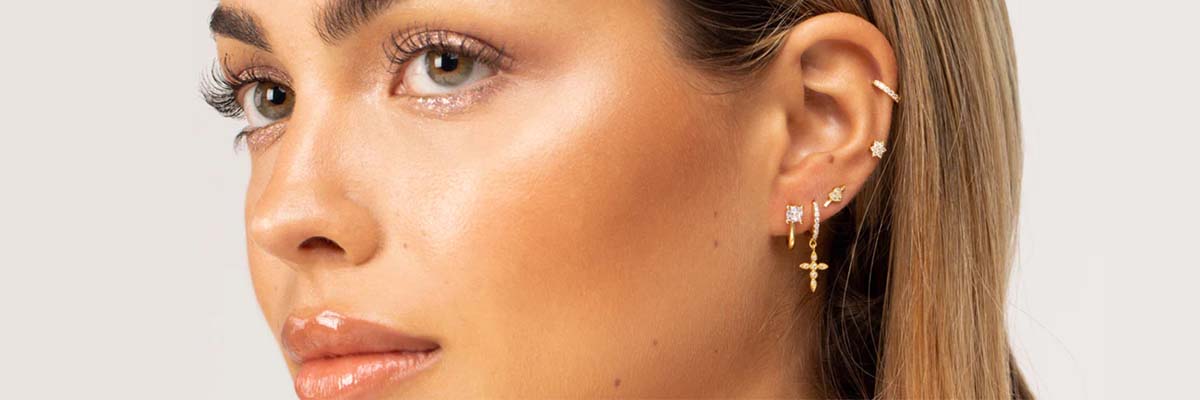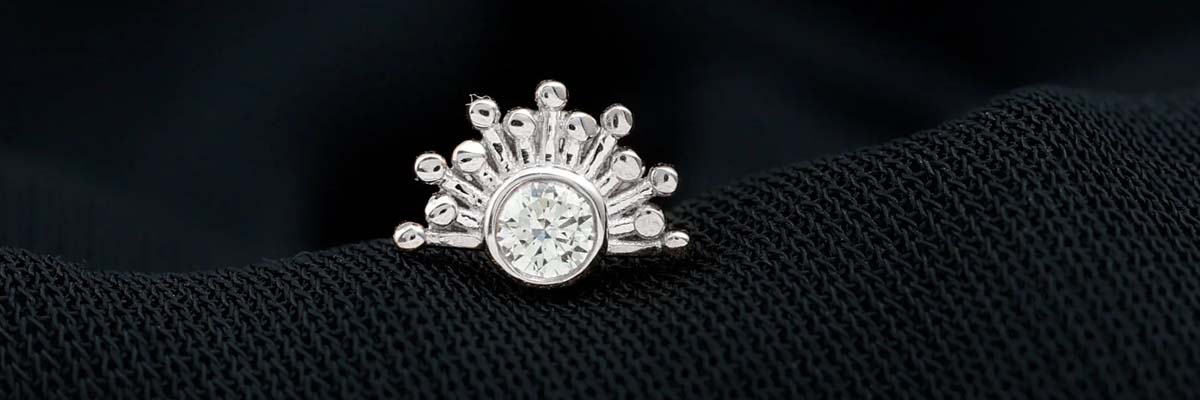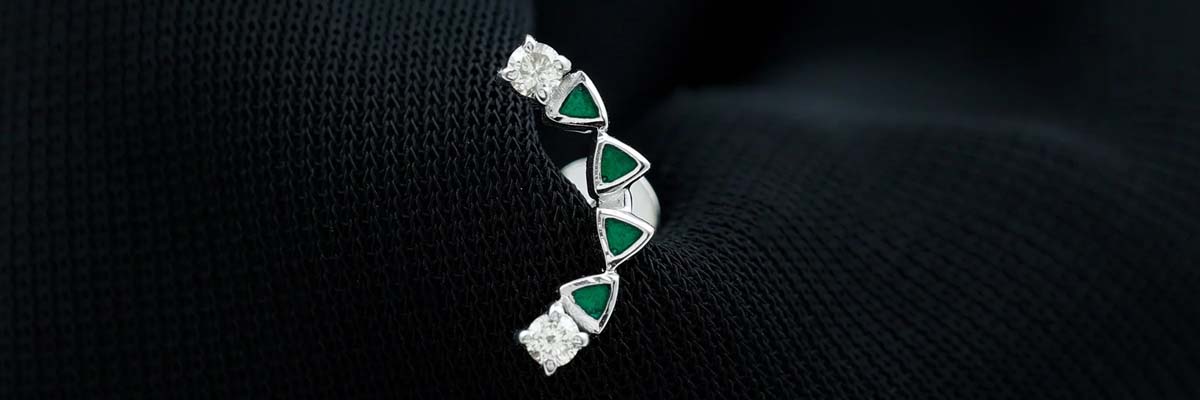Helix Piercing: Everything You Need to Know
With the fever of ear piercing taking over, we understand how difficult it is to resist surrendering to the trend and giving it a go. And speaking of trends, Helix Piercing has turned out to be the most fashion-forward choice of piercing that (more than anything) breathes life into those ear stack goals of yours. From your favorite celebs like Miley Cyrus, Scarlett Johansson, Cardi B, etc., to the girl next door that you probably adore for her chic sense of style, everybody has been seen going gaga over it.
And since you’re here, we bet you have secretly been fancying getting a Helix piercing yourself. But lack all the knowledge required to move forward with it? No worries! We have assembled a complete guide to introduce you to pretty much everything that you need to know- right from what a Helix piercing really is and its types to how to take care of it and the stunning styles of Helix jewelry. So, without further ado, let’s head forward:
What does a Helix Piercing mean?

First things first, a Helix Piercing, in simplest terms, stands for any piercing that is located at the upper and outward cartilage of the ear. That is why some even like to refer to it as Helix Cartilage Piercing.
You might find a tough time deciding on the exact location for getting this piercing. That’s precisely because the ear cartilage is home to a (significantly) larger area, which allows room for a number of piercings over here.
So right from a Forward and low or Mid Helix Piercing to double and triple Helix piercing, there are a myriad of piercing variations out there. But to save you from all the confusion, we’ve discussed each type of Helix piercing separately below:
Types of Helix Piercings
-
Standard Helix Piercing
Hands down the most classic and popular ear piercings out there, a Standard Helix Ear Piercing is positioned at the upper cartilage (on the outer rim) of the ear.
-
Forward Helix Piercing
A Forward Helix Piercing (true to what the name suggests) is positioned at the upper outer cartilage of the ear (closest to your face). If we define it in a more broader context, it is located right about the Tragus piercing. If you seek a more dramatic look, you could even go for a series of piercings in this area- a Double or Triple Forward Helix Piercing, for instance.
-
Mid and Low Helix Piercing
A standout among the common Helix Piercings, a Mid Helix Piercing is positioned at the middle of the outer ear rim. A Low Helix Piercing, on the other hand, is located specifically in the area just above the earlobe (along the outer rim of the ear). This placement allows for a unique and stylish look while still being relatively discreet.
-
Double and Triple Helix Piercing
You might have guessed it by the name by now that we’re not referring to the position of the piercing when speaking of a Double and Triple Helix Piercing. We’re explicitly speaking of the number of (multiple) piercings. A Double Helix Piercing involves two individual piercings that are positioned one about the other (in vertical alignment) along the cartilage of the Helix. On the other hand, if the number of piercings positioned above one another is three, it is referred to as a Triple Helix Piercing.
Cost Of Helix Piercing
Even if you speak of an expense as ordinary as getting your ears pierced, it’s best to think of the budget beforehand. But the important thing to note here is that the cost cannot be fixed since a large number of factors dictate it, right from the experience of the piercer, the studio you choose, the quality of Helix piercing jewelry used, etc.
Besides that, on an average, a Helix piercing cost ranges somewhere between $30 to $75.
How painful is helix piercing?

If you can’t gather the courage to go for a Helix Ear Piercing since the anticipation of the pain that you think you’re going to endure seems terrifying, don’t worry. It isn’t as bad as people generally think. In fact, you’d be glad to note that it is the least painful cartilage piercing (though more painful than an ear lobe one) that more or less, strikes a rating of 4-5 out of 10 on the pain scale. The simple reason behind that is the fact that the cartilage of upper ear is generally thinner and thus, doesn’t require much pressure (and skin) to perforate a hole.
Besides, if you ask us, the amount of Helix Piercing Pain also depends upon the piercing studio you choose (and we cannot stress that enough). If you go for a high end professional piercing studio, you’re most likely to endure less pain (and as an added advantage, can do away with the potential risks). That’s because the experience and skill of the piercer here will come in handy here to ensure a comfortable and reliable experience.
Time taken to Heal Helix Piercing
Once you get the piercing done and the tough part is officially over, we know the first question you’ll ask would be- how long would the piercing take to heal? So, let’s just discuss it beforehand.
Well, on an average, the complete Healing time for Helix Piercing can be anywhere between 6 to 12 months (though in the initial two to four months, you’ll see it healing a bit). We know the question that arises now is why is it so hard to heal a Helix Piercing or how does it take so long? Well, the simple (scientific) reason behind that boils down to the fact that (unlike an earlobe) a Cartilage is anything but a soft tissue piercing and the blood flow in the upper cartilage area is (comparatively) lower. So, it naturally takes more than usual for the wounds to heal and the tissue to regenerate.
Besides all that, the exact healing time and process largely varies from person to person since each body reacts differently. Moreover, it is also determined by the kind of aftercare process you treat your piercing to (consider that as your cue to do the aftercare right).
Helix Piercing : Jewelry Material
When you’re setting out to get a piercing, the last thing you want is an allergic reaction from the Helix piercing jewelry material used. So, make it a point to invest in earrings that have been crafted in a good quality metal. The most reliable ones are as follows:
-
Gold
Whether you speak in terms of aesthetics or safety purposes, Gold is hands down one of the best metals for Helix jewelry. It’s recommended to go for high-quality, nickel-free Gold Helix Earrings (that strike a metal purity of 14K or 18K) to do away with the risk of allergic reactions.
-
Titanium
If you suffer from metal allergies or reactions, Helix earrings crafted in Titanium (preferably an implant grand one) are the one for you. Owing to the hypoallergenic (nickel-free) nature and lightweight of this metal, it works as a safe bet for Helix piercings.
-
Surgical Stainless Steel
Another reliable choice of metal, Surgical Steel is famous for its durability, affordability, and hypoallergenic properties. Moreover, it is highly resistant to corrosion and tarnishing, keeping potential allergies at bay.
Helix Piercing Jewelry Style

We know it’s tough to wait for the piercing to completely heal before you can slip on your favorite jewelry into it. But while we cannot make the healing process any quicker, we can certainly introduce you to the many Helix Piercing Jewelry Styles that you’re sure to love adorning once it is all good and healed:
-
Stud
Stud Earrings are the official best friend of a Helix piercing. Typically small in size (to fit into the piercing comfortably), these earrings are decorated with a gemstone/diamond and possess a straight post that is directly inserted through the piercing. In terms of aesthetics, these Helix Piercing Earrings are treasured for their classic and elegant look.
-
Hoop
Hoop Earring is defined by a metal ring (circular or semi-circular in shape) that typically has a hinged or latch back closure. For aesthetic purposes, it usually features gemstones/diamond. If it is a chic and edgy look that you fancy, Hoop Earrings are the perfect way forward. Moreover, it is meant to create a seamless ear stack that complements multiple piercings such as a Double Helix Piercing.
Is a Helix Piercing Risky?
No piercing is immune to infections and scarring, but yes, Helix Ear piercing demands special attention since the blood flow in your upper cartilage is lower (as compared to an ear lobe). So, while the wounds take their own sweet time to heal, your piercing is rendered vulnerable to the risk of infections. However, that shouldn’t be a point of worry if you’re following the right precautions and after care (and lucky for you, we’ve saved this part for the last).
But first things first, let’s discuss the kind of side-effects that might trouble you if you’re sloppy with the after care.
Side Effects Of Piercing
-
Infections
When the Helix Cartilage Piercing is at its most vulnerable state, an infection is most likely to occur. The common symptoms to detect it are pain, redness, discharge, green or yellow pus, and swelling. If god forbid your piercing site suffers from any of these, seeking immediate medical help is in your best interest.
-
Scarring
If your piercing goes through harsh snagging, tearing, irritation, or simply over produces collagen for wound healing, it becomes more prone to developing a Scar. A Scar is nothing but the presence of hideous marks around the piercing site.
-
Keloids
Keloids are best defined as a more scary (and severe) form of scar. They are characterized by a raised and thick scar tissue (that is at times even larger than the original piercing). They usually develop in response to the trauma of the Piercing (be it a standard or Forward Helix Piercing) or due to genetic disposition.
Aftercare for Helix Piercing

Precaution is always better than cure and on that note, we’re about to introduce you to some quick after care tips and tricks that will keep you miles away from all the side-effects listed above.
-
No matter how compelled due to habit you are, don’t make the rookie mistake of touching your fresh Helix Cartilage Piercing time and again. Doing so can render it prone to infections, inflammation, or irritation. Whenever you have to touch it, make sure that your hands are thoroughly clean to avoid introducing bacteria to the piercing site.
-
Just like your Helix Piercing jewelry, the piercing site too calls for some religious cleaning (preferably once or twice a day). For that, you can make use of a pre made saline solution or a gentle, fragrance free cleanser specifically designed for piercings. Gently soak a clean cotton ball or pad in the solution and carefully clean around the piercing to do away with any crusted discharge or debris.
-
During the Helix Piercing Healing Time period, avoid wearing accessories like helmets, headphones, hats etc., since they are more likely to snag or tear your piercing. Moreover, hair products (like gel or sprays) are not your friends during this phase since they can go a long way in irritating your piercing.
-
Despite how tempted you get, try to avoid sleeping on the side of the piercing to prevent unnecessary pressure and irritation.
-
Before you switch the Helix jewelry, try to wait until the piercing is completely healed. Consult with your piercer for the appropriate healing time for your helix piercing.
Parting Note
Helix Piercing has lately emerged as the new cool and all the jewelry lovers out there are here to play along. But while you prep yourself to get one of those Helix Cartilage piercings, there are certain factors you need to be well versed with. And lucky for you, we have assembled all of them in this one stop guide. So, right from what a Helix piercing truly means, its variations, jewelry material and styles to the risks involved and how to keep them at bay, you’ll get to know it all and more in this blog. Hoping you had a lot take away from this discussion, we bid a warm adieu. Stay tuned for more of such interesting cum informative blogs!




